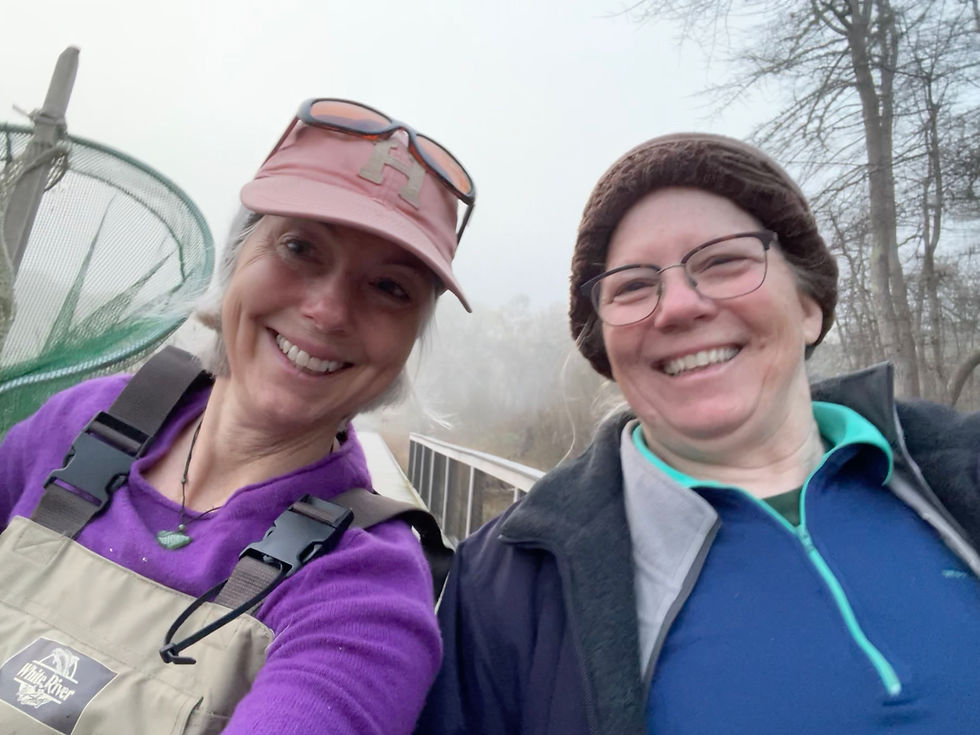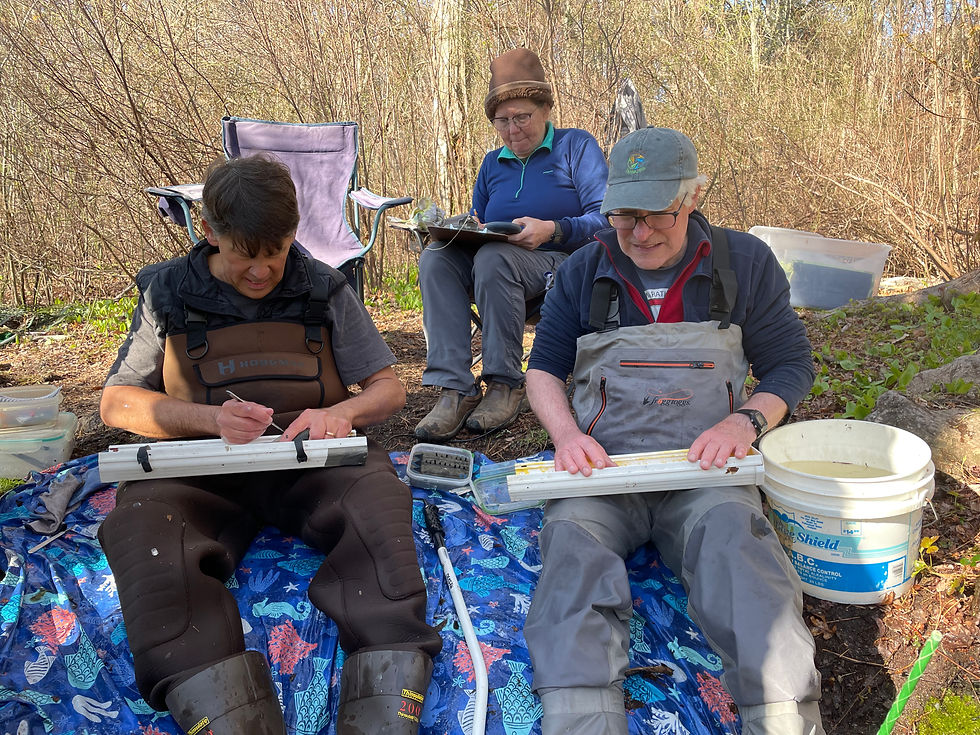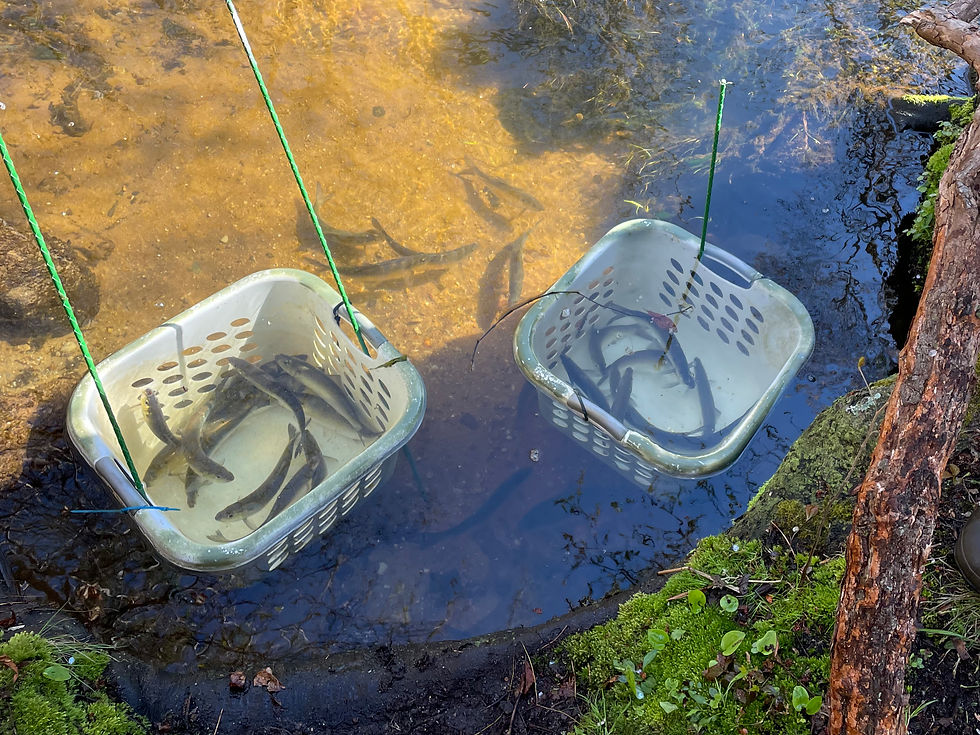Fishy Friday on the Coonamessett
- heidigolden3
- May 1, 2023
- 3 min read
It's the crack of dawn on a foggy April morning and the herring are running on the Coonamessett River in Falmouth, MA. This beautifully restored river once passed in a straight, flood-gated shot through cranberry bogs, which impeded fish migration. Today, those flood control gates have been removed and the river once again meanders through Cape Cod's sandy soils connecting Vineyard Sound with upstream herring spawning areas. I'm here today with the Coonamessett River Trust (CRT) to tag and track river herring (Alewife, Alosa pseudoharengus, and blueback, Alosa aestivalis) in efforts to monitor and restore the river's herring run. We use passive integrated transponder (PIT) tags with remote PIT-tag antenna arrays to help identify fish passage barriers, like undersized or poorly placed road culverts, and critical habitats for river herring. The antennas document tagged fish movement patterns as the fish migrate through the river system, think E-ZPass for fish. Loren Kellogg, species verification lead at NOAA's Northeast Fisheries Science Center, one of the few people I know who can spot a blueback among a trap-full of Alewife, arrived on site at 4:00 AM to set a trap. We proceeded to capture 165+ herring, that we then tagged with PIT-tags and set free -- back on their way to upstream spawning areas. Data from these PIT-tagged fish also aid educational outreach, where Falmouth Public School fourth-graders get to Adopt-a-Herring. If YOU want to adopt your own herring and follow its spawning journey, email the CRT here.

Figure 1. Riparian vegetation, large woody debris, and river meandering helped restore this section of the Coonamessett River that was once a cranberry bog.
I last saw the Coonamessett River in pre-pandemic 2019, when I worked with the CRT's fish monitoring and educational outreach programs. Ecosystem changes since then from river restoration appeared striking, including improved riparian vegetation growth, which provides cover for fish, and deepening of river pools from placement of river meanders and large woody debris (Figure 1).

Figure 2. Dr. Linda Deegan (senior scientist at the Woodwell Climate Research Center) and Dr. Golden (me), ready to wrangle herring!

Figure 3. Loren Kellogg and Martha's Vineyard High School student Sam Gurney discuss fish and fisheries, while patiently watching for up-migrating herring.
Our trap was set in a section of the Coonamessett River that was never used for cranberry farming. This river reach (Figures 3 and 4) has taller, thicker, more mature riparian cover and more diverse stream habitat and geomorphology than the restored river reach, providing better in-stream cover for fish from predators, like gulls and osprey. We hope one day that the restored river reach will be indistinguishable from this one.

Figure 4. Sam and Loren usher migrating river herring into the trap.

Figure 5. I measure, sex, and PIT-tag each herring, while Sam scribes the relayed data onto data sheets.

Figure 6. The Super-Scientist Tandem Herring Tagging Team! Dr. Chris Neill (senior scientist at Woodwell Climate Research Center, right), would likely rather be birding, but once again spends his morning working herring with Dr. Deegan (center) and Loren Kellogg (left).


Figure 7. Definitely in our "happy places," in the zen of fish wrangling (Dr. Golden, me, left) and data collecting (Dr. Deegan, right).

Figure 8. Tagged herring in recovery bins in the river.
Most of the fish we captured and tagged were Alewife (162 fish) and only a few were blueback (3 fish), which is often the case with river herring at this point in the season, because Alewife migration is usually slightly earlier in springtime compared to the blueback herring migration.

Figure 9. Fully recuperated herring, PIT-tagged and ready to swim though PIT-tag antennas on their way to spawning locations in the Coonamessett River system.

Figure 10. Herring PIT-tag tracks from the 2017 educational outreach program, Adopt-A-Herring. This particular herring was named "Mr. Millennium Falcon" by one of the Falmouth Public School's 4th grade students.
Once tagged (Figure 9), each Herring has a unique PIT-tag number that will be tracked over time through the Coonamessett River's system of PIT-tag antenna arrays as fish migrate up- and downstream, i.e., to the Coonamessett Pond, for spawning and back downstream to Vineyard Sound and out to sea. Figure 10 provides an example from a fish named "Mr. Millennium Falcon," a herring adopted and named by one of Falmouth Public School's 4th graders in 2017. Mr. Falcon was tagged at the 'Lower Bog Tag Site' on April 29. It then dropped downstream to 'Above Lower Dike,' then passed 'JP Crossing' on its way to the 'Coonamessett Pond.' It stayed for approximately one month (April 29th to May 29th) in the pond, then high-tailed it downstream past 'JP Crossing' and 'Lower Dike' to the sound. Just a reminder, if YOU want to Adopt-a-Herring, email the Coonamessett River Trust for more information.
Finally, one important question remains, "How many scientists does it take to tag a herring?" Today's answer, "At least four, and potentially one future five."




Comments